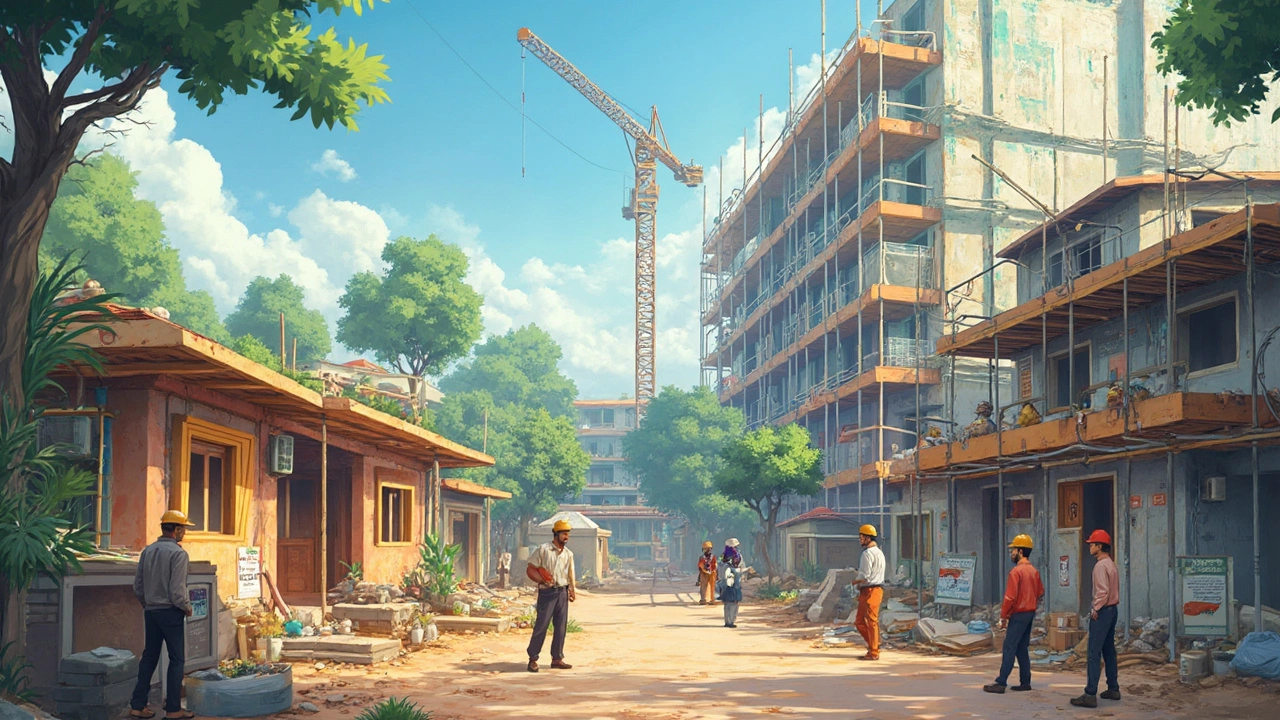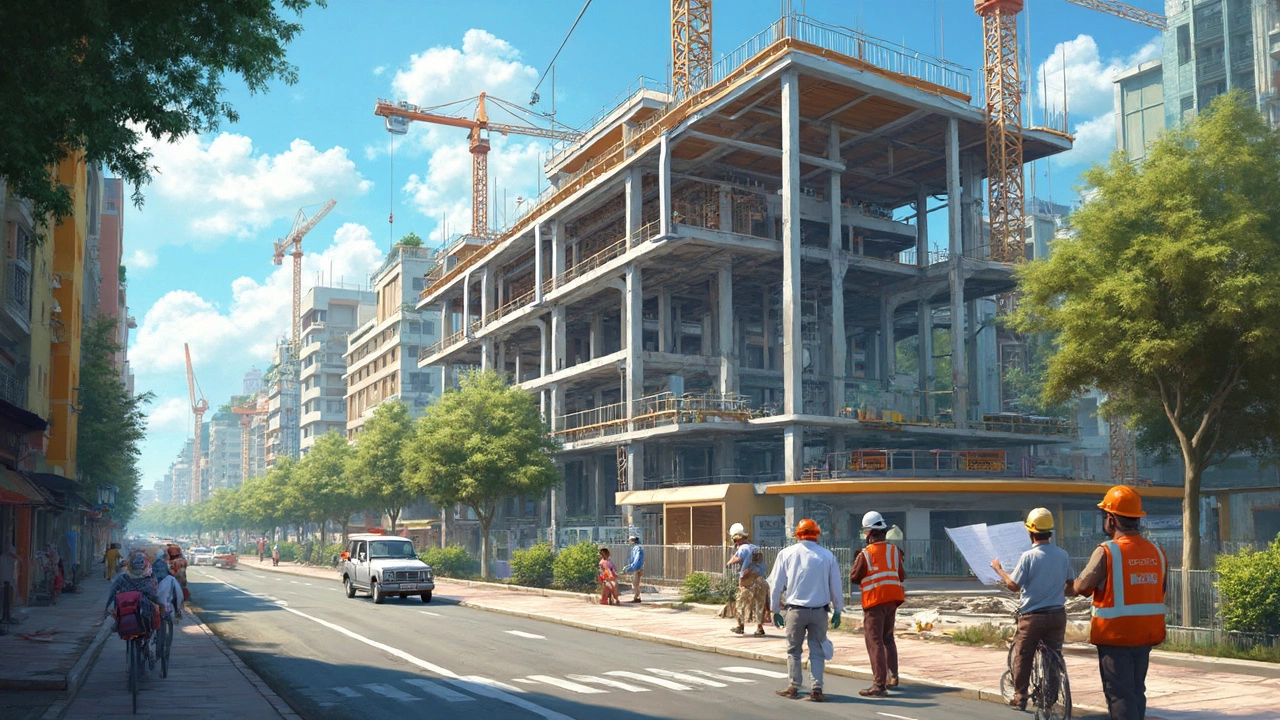Think building an office is just like putting up a house? Not even close. Commercial projects play by a different set of rules, starting with the building codes and permit requirements. For businesses, every safety measure is kicked up a notch—fire exits, ADA compliance, emergency lighting, the list goes on. Try skipping a step and you could stall the whole job for weeks, if not months.
Don’t expect quick signatures at city hall, either. Commercial permits are a beast. You'll need piles of paperwork, detailed engineering reports, and sometimes even public hearings. Home construction is usually much more straightforward, with checklists that are way easier to manage.
Then there’s the inspection schedule. Commercial inspectors show up at every big milestone. They want every beam, wire, and sprinkler head perfectly in place. With houses, inspectors check the basics—foundation, framing, plumbing, and you’re moving along. Get this wrong on a commercial job, and that could easily throw your timeline (and budget) out the window.
- Codes, Permits, and Inspections: The Rules Change
- Size, Scope, and Complexity
- Money, Timelines, and Risks
- Teams and Subcontractors: Who Does What
Codes, Permits, and Inspections: The Rules Change
Here’s the deal: the rules for commercial construction aren’t just stricter—they’re built for a whole different world. City codes for a store or office building cover everything from electrical systems to fire alarms. The days of just calling up the city to get a home permit are gone. For commercial sites, you’ll be juggling approvals from fire marshals, ADA inspectors, and sometimes even state environmental boards.
Let’s look at the numbers. A recent survey by the National Association of Home Builders reports that getting a commercial building permit takes, on average, two to six months. Compare that to most residential permits, which often wrap up in 30 to 45 days. Why? Commercial plans must include steel structures, sprinkler systems, commercial-grade HVAC, and much more. Every system gets a close review.
| Project Type | Average Permit Time | Typical Inspection Points |
|---|---|---|
| Commercial | 2-6 months | 10-15 |
| Residential | 1-1.5 months | 4-6 |
Commercial inspectors aren’t just checking that you used the right nails. They review fire exit routes, elevator safety, ADA bathrooms, energy efficiency—all designed with public safety in mind. Miss one detail, and you’re not moving to the next phase.
Also, commercial projects almost always need special zoning approval. Want to turn an old warehouse into a microbrewery? You’ll likely need to face a zoning board and maybe even answer questions from the public. None of that happens when you’re gutting a kitchen at home.
- Bring in experts—engineers and architects who know the code inside out.
- Stay organized: keep digital files of every permit, report, and revision. Audits and re-submissions are a given.
- Plan for delays. Make permit approvals and inspections a line item in your project timeline and expect to adjust.
If you skip these steps or guess at the requirements, it’ll cost you. Double and even triple inspections are common if the paperwork or build-out isn’t fully up to commercial construction codes. It’s not just about building—it's about proving you’ve built it right, every single step.
Size, Scope, and Complexity
The first thing that hits you about commercial construction is how much bigger and more demanding the jobs are. While a typical American house might run about 2,500 square feet, commercial projects can be 10, 20, or even 100 times that size. Consider a local strip mall or a four-story medical building—these aren’t just about putting up more walls. They’re about supporting heavy loads, planning for hundreds of people moving through, and keeping multiple systems running at once.
The mechanical and electrical systems alone make things hairy. Commercial buildings have serious HVAC (heating, ventilation, air conditioning) needs, not to mention elevators, automatic sprinklers, and high-capacity wiring for lighting and tech. These aren’t afterthoughts. They get engineered up front with blueprints running dozens of pages. Once steel beams and utility trenches are in place, changes get expensive and messy.
Then there’s scheduling. Residential jobs usually keep a single crew busy, plugging away week after week. With commercial projects, you’re juggling plumbers, electricians, glaziers, concrete specialists, and more—sometimes all working at the same time. If one team misses a deadline, it can set off a domino effect that stalls the whole project.
It isn’t just size—it’s also about customization. In a home, you pick out cabinets and flooring. In a commercial building, you may need to coordinate specialty labs, restaurants, secure server rooms, or health clinics. Each comes with its own codes and requirements. The commercial construction world deals with unique structural challenges like larger open floor spaces, heavier roofs, and stricter fire zones.
Here’s the kicker—commercial failures are costly. If something goes wrong, you’re not just disappointing a family. You could be on the hook for lost business, serious legal fees, and big repair bills. That’s why these projects need careful planning, regular meetings, and clear communication from day one.

Money, Timelines, and Risks
Money gets weird fast in commercial construction. A typical office build easily runs into the millions, while a decent-sized house might top out at a few hundred grand. The differences don’t stop at the price tag. Commercial projects burn through cash on professional fees, permits, and way more insurance. Miss a detail and you’ll pay for it—change orders on office builds can cost tens of thousands more than you’d ever see on a residential site.
Let’s look at some real numbers. In the U.S., a new office building averages about $300–$500 per square foot. Compare that with around $150–$225 per square foot for a new house, depending on where you live and what you want. And commercial projects don’t ever move as fast as home builds: a small shop might wrap up in 6 months, but a big retail complex can eat up two years or more.
| Project Type | Average Cost/Sq Ft | Average Timeline |
|---|---|---|
| Residential Home | $150–$225 | 6–12 months |
| Office Building | $300–$500 | 12–24 months |
| Retail Complex | $350–$750 | 18–30 months |
Risk? It’s everywhere in commercial work, and it can get expensive fast. Imagine you mess up on a fire alarm system in an apartment building. You’ll be paying for emergency fixes, new inspections, and maybe even get hit with a stop-work order. Businesses lose rental income, your reputation takes a hit, and suddenly, lawyers are on speed dial. Even weather delays make a bigger mess—commercial contracts usually have steep penalties if you don’t deliver on time.
To stay out of trouble, always budget a healthy cushion (at least 10–20%) for hiccups, stick to your planned schedule, and never cheap out on insurance or legal advice. It’s easy to think you can wing it—until you’re staring at a half-built slab and an empty bank account.
Teams and Subcontractors: Who Does What
The people running a commercial construction project are not your average home-building crew. The team is usually bigger, and jobs are split up in ways that might surprise you if you've only dealt with residential stuff. There’s way more paperwork and coordination.
On commercial sites, you’ll definitely see a project manager, and sometimes an owner’s rep, who’s basically there to make sure the owner’s money is spent wisely. There are also site superintendents keeping the job on track every single day. You might run into quality control managers, safety officers, and even full-time schedulers. That’s not counting the pile of subcontractors, each focused on their narrow specialty.
Here’s a quick breakdown to show just how different the teams can get:
| Role | Commercial Construction | Residential Construction |
|---|---|---|
| Project Manager | Always present, coordinates dozens of subs | Sometimes, usually wears multiple hats |
| Superintendent | Dedicated by project phase or area | May also be the builder or head contractor |
| Subcontractors | Specialized (e.g., fire suppression, HVAC controls) | Fewer subs, broader job scopes |
| Inspections | Conducted by safety and quality managers | Handled by local building inspectors |
| Paperwork | Full-time admin, on-site office | Usually done by builder on the side |
With commercial jobs, the number of subcontractors can get wild—think 30 or more. They come in waves: concrete teams, glaziers, elevator installers, wiring and IT—not to mention the regular plumbers and electricians. Everything needs tight scheduling because if one team slips, it can set off a domino effect. Compare that to housing projects, where you might use just a handful of trusted local subs for everything.
Want one quick tip? If you're ever involved with commercial work, make sure you use software to keep everyone’s tasks and timelines straight. There are platforms like Procore and Buildertrend designed just for this chaos, and studies show they can shave weeks off bigger projects because everyone stays in sync.

Written by Fletcher Abernathy
View all posts by: Fletcher Abernathy